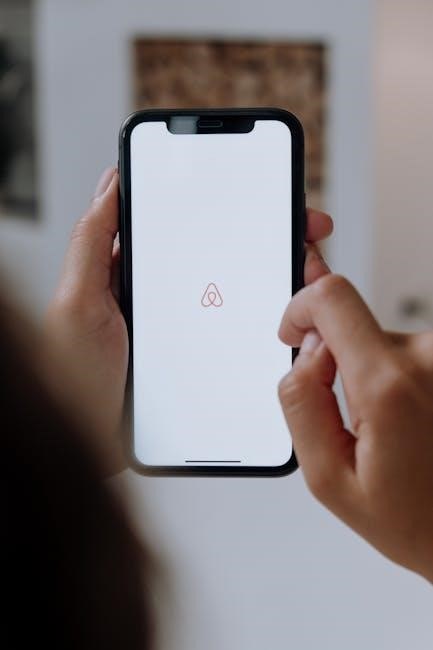Welcome to the Honeywell wireless thermostat user manual. This guide provides step-by-step instructions for installation, setup, and troubleshooting your smart thermostat. Learn how to optimize energy efficiency and customize settings for seamless comfort control.

Installation Steps
Install your Honeywell wireless thermostat by following these steps: Mount the wallplate, connect wires, attach the thermostat, and secure it. Ensure proper wiring and compatibility for optimal performance.
2.1 Pre-Installation Checklist
Before installing your Honeywell wireless thermostat, ensure you have the following: a compatible HVAC system, a C-wire (if required), and a stable Wi-Fi connection. Verify the thermostat’s compatibility with your system’s voltage and wiring configuration. Gather all necessary tools, such as a screwdriver and wire strippers. Turn off the power to your HVAC system at the circuit breaker. Review the user manual to understand the wiring diagram and installation process. Ensure the wallplate is properly prepared and any old thermostat is removed. Double-check that all components, like batteries, are included in the packaging.
2.2 Wiring and Compatibility
Ensure your Honeywell wireless thermostat is compatible with your HVAC system’s wiring and voltage. Most models require a C-wire for consistent power, but some are designed to function without one. Verify the wiring configuration by checking the existing thermostat’s connections. Match the wires to the appropriate terminals on the new thermostat, following the user manual’s wiring diagram. If unsure, consult a professional. Compatibility with systems like heat pumps, gas furnaces, or electric systems varies by model, so confirm your thermostat supports your specific setup before proceeding with installation.
2.3 Mounting the Thermostat
Mounting your Honeywell wireless thermostat is straightforward. Start by grasping the finger holds on the top and bottom of the wallplate with one hand and the thermostat with the other. Gently pull the two pieces apart to separate them. Align the wallplate with the mounting screws on the wall, ensuring it is level and secure. Once properly aligned, push the thermostat back onto the wallplate until it clicks into place. Make sure the device is firmly attached to avoid any movement or damage. The thermostat is pre-set to maintain a comfortable temperature when you’re home and energy-saving levels when you’re away or asleep. Refer to the user manual for specific model details.
2.4 Powering On the Device
After mounting the thermostat, power it on by ensuring the batteries are correctly installed or the wiring is properly connected. The device will automatically turn on and display the initial setup screen. Check that the display lights up and shows the default program schedules. If the thermostat is battery-powered, ensure the batteries are fresh and correctly inserted. For hardwired models, verify that the power source is activated. Once powered on, the thermostat will guide you through the initial setup process. Follow the on-screen instructions to complete the configuration. If the device does not power on, refer to the troubleshooting section in the user manual.

Initial Setup
Connect your Honeywell thermostat to Wi-Fi, register the device, and complete the first-time configuration. Follow on-screen instructions to set up schedules and preferences for optimal performance.
3.1 Connecting to Wi-Fi
To connect your Honeywell wireless thermostat to Wi-Fi, ensure the device is in setup mode. Select your home network from the available options, enter the password, and confirm. The thermostat will automatically connect to the internet. If connection fails, restart the device and retry. Ensure your router is functioning properly and the thermostat is within range. Once connected, a confirmation message will appear on the screen. This step is essential for remote access and smart features. Refer to the user manual for detailed instructions if issues persist.
3.2 Registering the Thermostat
After connecting to Wi-Fi, register your Honeywell thermostat to enable remote access and advanced features. Visit the Honeywell Home website or use the mobile app to create an account. Enter the thermostat’s MAC ID, found on the device or packaging, to complete registration. Follow the on-screen instructions to link your thermostat to your account. Once registered, you can control your thermostat remotely, receive notifications, and access energy usage reports. Ensure you have a valid email address and password for account creation; Registration is essential for unlocking full functionality and integrating with smart home systems. Refer to the user manual for detailed registration steps.
3.3 First-Time Configuration
After connecting to Wi-Fi and registering your thermostat, proceed with the first-time configuration. Access the menu by tapping the touchscreen or using the Honeywell Home app. Set your location, preferred temperature units (Fahrenheit or Celsius), and schedule preferences. Review the default program, which maintains comfortable temperatures when home and energy-saving levels when away or asleep. Customize the schedule to match your daily routine, adjusting heat and cool settings as needed. Ensure to save your changes to apply the new configuration. This step ensures your thermostat operates efficiently and aligns with your lifestyle. Refer to the user manual for additional customization options and advanced settings.

Features and Functionality
The Honeywell wireless thermostat offers advanced features like scheduling, smart home integration, and energy-saving modes. It optimizes comfort and energy efficiency, ensuring seamless temperature control and remote access convenience;
4.1 Scheduling Capabilities
The Honeywell wireless thermostat allows users to create custom schedules for optimal temperature control. With pre-programmed settings, you can set different temperatures for home, away, and sleep periods. The thermostat learns your preferences and adjusts automatically, ensuring energy efficiency. It also supports geofencing, adjusting temperatures based on your location. Users can schedule up to six periods per day, with options for weekdays and weekends. Remote access via the Honeywell app enables adjustments on the go. This feature ensures your home is always comfortable while minimizing energy usage, making it ideal for busy households with varying routines.
4.2 Smart Home Integration
The Honeywell wireless thermostat seamlessly integrates with popular smart home systems, enhancing your home automation experience. Compatible with Amazon Alexa and Google Home, you can control temperatures using voice commands. This integration allows for effortless adjustments, ensuring your home stays comfortable without manual intervention. The thermostat also works with other smart devices, creating a unified system for energy management. By connecting to your smart home network, you can access advanced features like geofencing and remote scheduling. This compatibility ensures your thermostat adapts to your lifestyle, providing convenience and energy efficiency. Smart home integration makes managing your comfort easier than ever, from anywhere in the world.
4.3 Energy-Saving Modes
The Honeywell wireless thermostat offers advanced energy-saving modes to reduce consumption without compromising comfort. These modes include automatic adjustments when you’re away or asleep, optimizing energy use. The thermostat also features smart recovery, learning your system’s performance to pre-heat or cool, ensuring efficiency. Geofencing technology integrates with your smartphone’s location, adjusting temperatures based on your proximity to home. Additionally, the thermostat provides energy usage reports, helping you identify savings opportunities. These modes work seamlessly with smart home systems, further enhancing energy efficiency. By utilizing these features, you can significantly lower your energy bills while maintaining a comfortable living environment. Energy-saving modes make conservation effortless and effective.

Operation and Control
Operate your Honeywell wireless thermostat effortlessly with its intuitive touchscreen interface. Adjust temperature settings, access smart features, and enjoy seamless smart home integration for enhanced comfort and efficiency.
5.1 Basic Operations
Mastering basic operations of your Honeywell wireless thermostat ensures smooth functionality. Adjust the temperature by touching the screen or using the physical buttons. Switch between heat, cool, or fan modes effortlessly. Use the programmable schedule to set temperature preferences for different times of the day. The thermostat’s intuitive interface allows you to toggle between energy-saving modes and manual overrides. For quick adjustments, the touchscreen display provides clear feedback. Additionally, the device automatically switches between heating and cooling based on your settings. Regularly check the display for system status updates. If issues arise, restarting the thermostat often resolves minor glitches. Explore these features to optimize comfort and energy efficiency.
5.2 Using the Touchscreen
The Honeywell wireless thermostat features an intuitive touchscreen interface designed for easy navigation. To adjust the temperature, simply tap the up or down arrows on the screen. Swipe left or right to access additional menus, such as scheduling or system settings. The touchscreen is responsive, ensuring smooth transitions between options. For mode selection, tap the heat, cool, or fan icon to switch. The display provides clear visual feedback, making it easy to confirm changes. Regularly clean the screen with a soft cloth to maintain responsiveness. Avoid using harsh chemicals, as they may damage the display. Familiarize yourself with these gestures to optimize your thermostat’s performance.
5.3 Understanding the Display
The Honeywell wireless thermostat’s display provides a clear overview of your heating and cooling system. It shows the current temperature, setpoint, and system status, such as heating, cooling, or fan operation. Icons on the display indicate the active mode, helping you understand the system’s current state. The screen also displays Wi-Fi connectivity status and battery level, if applicable. The default program is pre-set for energy efficiency, maintaining a comfortable temperature when you’re home and adjusting to energy-saving levels when you’re away or asleep. Familiarizing yourself with these elements ensures optimal use of your thermostat’s features.

Maintenance and Care
Regularly clean the thermostat to ensure proper function. Check and replace batteries as needed. Update software for the latest features and efficiency. Maintain optimal performance and energy efficiency.
6.1 Cleaning the Thermostat
Regular cleaning ensures your Honeywell wireless thermostat operates efficiently. Use a soft, dry cloth to gently wipe the touchscreen and exterior. Avoid harsh chemicals or liquids, as they may damage the device. For stubborn marks, lightly dampen the cloth with water, but ensure no moisture seeps inside. Clean the sensors on the back to maintain accurate temperature readings. Avoid touching the screen excessively, as oils from skin can leave smudges. If the thermostat is battery-powered, remove batteries before cleaning. Proper maintenance prevents dust buildup and ensures optimal performance. Refer to the user manual for specific cleaning instructions tailored to your model.
6.2 Replacing Batteries
To replace the batteries in your Honeywell wireless thermostat, first ensure you have the correct type (usually AA alkaline); Turn the thermostat off and detach it from the wallplate. Open the battery compartment, located on the back or bottom, and remove the old batteries. Insert the new ones, matching the polarity indicated. Replace the compartment cover and reattach the thermostat to the wallplate. Turn it back on and wait a minute for it to reset. If the display remains blank, check the battery connections. For models with rechargeable batteries, refer to the user manual for charging instructions. Always use high-quality batteries for optimal performance.
6.3 Software Updates
Regular software updates ensure your Honeywell wireless thermostat operates at peak performance. To check for updates, navigate to the settings menu on your thermostat or through the Honeywell Home app. If an update is available, select “Update” and follow the on-screen instructions. The device will download and install the new software automatically. During this process, the thermostat may restart briefly. Once complete, your system will be optimized with the latest features and security enhancements. Always ensure your thermostat is connected to Wi-Fi before attempting an update. For detailed steps, refer to the user manual or contact customer support if issues arise.

Troubleshooting Common Issues
Identify and resolve common issues with your Honeywell wireless thermostat, such as error codes or connectivity problems. Check the user manual for specific solutions or restart the device if needed.
7.1 Common Problems
Users may encounter issues like error codes, connectivity problems, or display malfunctions. Check for loose wiring or incorrect connections. Ensure the thermostat is properly registered and connected to Wi-Fi. If the display is unresponsive, restart the device. For error codes, refer to the user manual for specific solutions. If issues persist, resetting the thermostat to factory settings may resolve the problem. Always consult the manual for troubleshooting steps before contacting customer support. Regular software updates can also prevent or fix common issues. Ensure batteries are fresh if the thermostat is battery-powered. Addressing these problems early ensures optimal performance and comfort.
7.2 Error Codes
Honeywell wireless thermostats may display error codes indicating specific issues. Common codes include E1, E2, and E3, which relate to temperature differences, sensor malfunctions, or system errors. Refer to the user manual for code meanings and solutions. For example, E1 often signifies a large temperature difference between setpoint and actual temperature. E2 may indicate a sensor issue, while E3 could point to a system malfunction. Restarting the thermostat or checking wiring can resolve many errors. If codes persist, reset the device to factory settings or contact customer support for assistance. Regular software updates and proper installation can help prevent error codes from occurring. Always consult the manual for specific troubleshooting steps.

7.3 Resetting the Thermostat
To reset your Honeywell wireless thermostat, follow these steps. First, remove the device from the wallplate by gently pulling it away. Locate the reset button, usually found on the back or bottom of the thermostat. Press and hold the reset button for 5-10 seconds until the display goes blank. Release the button and wait for the thermostat to restart. This process restores factory settings, erasing all custom configurations. Note that resetting will clear schedules and preferences, so you’ll need to reconfigure them afterward. Resetting is useful for resolving persistent issues or preparing the thermostat for a new installation. Always refer to the manual for specific reset instructions.

Advanced Settings and Customization
Explore advanced settings to customize your Honeywell wireless thermostat. Adjust temperature limits, create custom schedules, and integrate with smart home systems for enhanced control and efficiency.
8.1 Customizing Settings
Customizing your Honeywell wireless thermostat allows you to tailor settings to your preferences. Adjust temperature ranges, create custom schedules, and enable energy-saving modes. Access advanced features like geofencing and smart alerts through the Honeywell Home app. Modify fan settings, humidity levels, and system modes to optimize comfort. Set temperature limits to prevent extreme highs or lows. Customize the display brightness and backlight timing for convenience. Explore smart home integrations to sync with other devices. These settings ensure your thermostat works seamlessly with your lifestyle, providing enhanced efficiency and control. Refer to the user manual for detailed steps on accessing and adjusting these options.
8.2 Smart Home Systems
Your Honeywell wireless thermostat seamlessly integrates with popular smart home systems like Amazon Alexa and Google Home. Enable voice control to adjust temperatures hands-free. Use the Honeywell Home app to sync your thermostat with other smart devices, creating a unified home automation experience. Set up routines and scenes to automatically adjust settings based on your daily activities. Remote access allows you to monitor and control your thermostat from anywhere. Compatibility with IFTTT (If This Then That) expands customization options. Ensure your system is updated to the latest software for optimal integration. Refer to the user manual for specific pairing instructions and compatibility details.
8.3 Temperature Limits
Set custom temperature limits on your Honeywell wireless thermostat to maintain optimal comfort and energy efficiency. The default range is typically 40°F to 90°F for heating and cooling. Adjust these limits via the Honeywell Home app or the thermostat’s touchscreen. Locking temperature settings ensures consistent comfort levels. Energy-saving modes automatically adjust within your set limits. For advanced control, schedule temperature adjustments based on occupancy or time of day. Refer to the user manual for detailed instructions on configuring temperature limits and customizing energy-saving profiles. This feature helps balance comfort and energy usage, ensuring your home stays efficient without sacrificing convenience.

Warranty and Support
Your Honeywell wireless thermostat is backed by a comprehensive warranty. Visit the Honeywell website for detailed warranty terms and to contact customer support for assistance.
9.1 Warranty Overview
Your Honeywell wireless thermostat is backed by a comprehensive warranty program. Most models come with a standard 5-year limited warranty covering defects in materials and workmanship. This warranty ensures repairs or replacements are handled at no additional cost during the coverage period. For specific details, visit the Honeywell website or refer to the product documentation provided with your thermostat. The warranty may vary depending on the model and region, so it’s essential to review the terms and conditions. Additionally, Honeywell offers dedicated customer support to address any warranty-related inquiries or concerns.
9.2 Contacting Customer Support
For assistance with your Honeywell wireless thermostat, visit the official Honeywell website, where you’ll find a dedicated support section. You can contact customer support via phone, email, or live chat. Be prepared to provide your thermostat model number and a detailed description of your issue. Honeywell’s support team is available to help with troubleshooting, warranty claims, and general inquiries. Additionally, the website offers extensive resources, including FAQs, user manuals, and troubleshooting guides. For urgent matters, 24/7 support is available in select regions. Honeywell is committed to ensuring a smooth and efficient experience for all users.
This comprehensive guide has covered everything you need to know about installing, configuring, and maintaining your Honeywell wireless thermostat. By following the steps outlined, you can optimize energy efficiency, customize settings, and enjoy seamless smart home integration. Remember to regularly update your thermostat’s software and refer to the troubleshooting section for any issues. Honeywell’s customer support is always available to assist with any concerns. With proper care and use, your thermostat will provide years of reliable service, enhancing your home’s comfort and energy savings. Explore advanced features and settings to tailor your experience further. Happy heating and cooling!